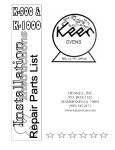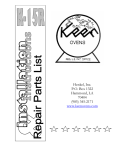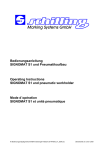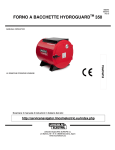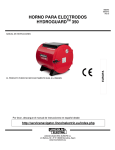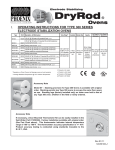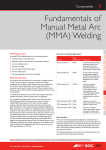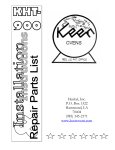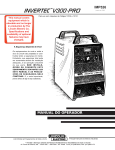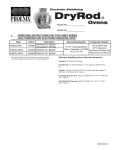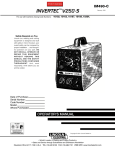Download DryRod II® - Phoenix International
Transcript
Electrode Stabilizing DryRod d II ® Ovens I. OPERATING INSTRUCTIONS FOR TYPE 2 SERIES PORTABLE ELECTRODE STABILIZATION OVENS Part Number Description - (All 50-60 cycles) Temperature Range 1205510 120/240V AC* @ 150 watts (digital thermometer installed) 1205512 120/240V AC* @ 150 watts (without digital thermometer) *Operation on Direct Current will damage oven and void warranty 100°-300°F (38°-149°C) Adjustable Thermostat Electrode Stabilizing DryRod®II Ovens General Information: Insulation: 1 1/2” (3.8cm) fiberglass Chamber Size: 3 7/8” (9.8cm) dia. x 19 3/4” (50.2cm) deep Capacity: 20lbs (10kg) 18" (45.7cm) Net Weight & Dimensions: 15.3lbs (6.9kg) 7 3/4” x 9 1/4” x 23” ; 19.7 x 23.5 x 58.4 cm Ship Weight & Dimensions: 17lbs (7.7kg) 9” x 11” x 24” ; 23 x 28 x 61 cm *Caution* To avoid oven damage, never place oven in contact with welding current. Phoenix International, Inc. • 8711 West Port Avenue • Milwaukee, WI 53224 USA Phone (414) 973-3400 • Fax (414) 973-3210 • www.phx-international.com • [email protected] N5610455B-1 Estabilizador de Electrodos DryRod d II ® Hornos I. INSTRUCCIONES OPERATIVAS PARA HORNOS PORTÁTILES DE ESTABILIZACIÓN DE ELECTRODOS SERIE TIPO 2 Numero de Parte 1205510 1205512 Descripcion - (Todos los ciclos 50-60) 120/240V AC* @ 150 voltios (termostato digital instalado) 120/240V AC* @ 150 voltios (sin termostato digital) *La operación de horno con corriente directa dañara el horno y caduca la garantía Rangos de Temperatura 100°-300°F (38°-149°C) Termostato Ajustable Información general del Horno Estabilizador DryRod®II de Electrodos: Aislamiento: 1 1/2” (3.8cm) fiberglass Tamaño de la cámara: 3 7/8” (9.8cm) dia. x 19 3/4” (50.2cm) deep Capacidad: 20lbs (10kg) 18" (45.7cm) Peso Neto y Dimensiones: 15.3lbs (6.9kg) 7 3/4” x 9 1/4” x 23” ; 19.7 x 23.5 x 58.4 cm Peso Bruto para Embarque y Dimensiones: 17lbs (7.7kg) 9” x 11” x 24” ; 23 x 28 x 61 cm *ADVERTENCIA* Para prevenir daños al horno, nunca ponga el horno en contacto con corriente de soldadura. Phoenix International, Inc. • 8711 West Port Avenue • Milwaukee, WI 53224 USA Phone (414) 973-3400 • Fax (414) 973-3210 • www.phx-international.com • [email protected] N5610455B-1 II. OVEN TYPE DESCRIPTION Prior To Use: 1. Check that the voltage selector switch setting corresponds with the power supply to be used. Unit is set to 120V when shipped. 2. Check for correct power supply cord. Unit is supplied with 120V North American configuration. 3. Check for desired thermometer (if equipped) display units (°F or °C). Unit is set to °F when shipped. To change to °C, see Section III in this manual. Power Supply Check the nameplate for voltage ratings. Type 2 ovens are supplied with a voltage selector switch to operate on either 120 or 240 AC voltage. Please be sure to set the switch to the proper voltage being used. The ovens are supplied with an indicator light which indicates the unit is energized. Power Cords The ovens are supplied with a female, IEC 320 power cord inlet. This inlet accepts a male, IEC 320 power cord. Type 2 ovens are supplied with a three blade, grounded, North American cord for 120V AC operation. When connected to a properly grounded receptacle, these ovens meet the nationally recognized standards for which they are marked. For operation on 240V AC, a different power supply cord must be used. One side must be configured with the IEC 320 male end. Optional configurations are available for the other end, including North American, European, etc. These maybe purchased locally or through Phoenix International, Inc. An optional cord retainer clamp kit is available to provide a stationary cord. (P/N 1257570) ** CAUTION ** To provide continued protection against risk of electrical shock, power cord must be connected to a properly grounded outlet. Electrode Storage Type 2 series ovens are not airtight and electrodes stored within will start absorbing ambient moisture as soon as the oven cools. We recommend removal of electrodes at shift end and storage of same consumables in suitable larger holding ovens until reissued. These ovens are not to be used for rebaking or reconditioning contaminated electrodes. They are designed to accept electrodes in 100% useable condition and to maintain that condition until consumed at the job site. For optimum stabilization, oven should be hot when loaded and kept “on line” as long as electrodes are being stored. Guide to Storage In the absence of detailed storage information from your electrode manufacturer, the "Guide To Electrode and Flux Stabilization" (see last page of operators manual) may be used as an indication of approximate temperatures. (A laminated version and poster size version is available by contacting Phoenix International, Inc.) For specific information involving critical operations be sure to contact your electrode manufacturer for complete information. Repair - Spare Parts These instructions contain wiring diagrams and a repair parts list for your oven. For critical welding operations requiring continuous holding, we would suggest carrying all of the parts listed in the “Suggested Spare Parts Section VII” of these instructions. Temperature Settings Type 2 ovens utilize a variable thermostat, providing an operating range of 100°-300°F (38°-149°C) average stabilized load temperatures. The oven operating temperature is set by rotating the thermostat knob clockwise to increase the temperature of the unit. To decrease the temperature rotate the knob counter-clockwise. This setting is approximate and may need slight adjustment once the oven temperature stabilizes. Temperature Indication Type 2 ovens (P/N 1205520) are supplied with a battery powered, digital thermometer to indicate the actual inside oven temperature in either °F or °C. The thermometer will indicate a numeric reading up to 300°F (149°C). "HHH" indicates the oven is fully heated. The thermometers are supplied in the °F mode. Conversion to the °C mode is accomplished by simply moving the switch (located in the battery holder) to the opposite position, as described in the troubleshooting section of this manual. Replacement of the battery is also covered in the troubleshooting section of this manual. ** CAUTION ** Unit not to be exposed to rain or moisture. Store only in dry location. Phoenix International, Inc. • 8711 West Port Avenue • Milwaukee, WI 53224 USA Phone (414) 973-3400 • Fax (414) 973-3210 • www.phx-international.com • [email protected] N5610455B-2 II. DESCRIPCION DE TIPOS DE HORNO Antes del uso: 1.Verifique que el voltaje del interruptor que se va a utilizar corresponda con suministro de energía utilizado. Las unidades establecidas al enviar son de 120V. 2.Verifique que el cable de poder sea el adecuado. La unidad viene con una configuración 120V Norteamericana. 3.Verifique la indicación deseada del termómetro (si lo posee).(F o C) Las unidades vienen predeterminadas es en F. Para cambiar a C, ver sección III de este manual. Entrada de Corriente Verificar la placa de identificación para ver rangos de voltaje. El horno tipo 2 viene con un interruptor que selecciona el voltaje para operar en 120 o en 240 AC. Por favor asegúrese seleccionar con el interruptor el voltaje apropiado. Los hornos incluyen una luz indicadora que muestra si la unidad esta con energía. Cables de Poder Los hornos incluyen un cable de entrada de poder femenino IEC 320. La entrada de poder acepta un cable masculino de IEC 320 Los hornos tipo 2, vienen con un cable Norteamericano de tres navajas en tierra., para operaciones de 120V AC. Cuando se conecta en tierra receptora debidamente, estos hornos cumplen con los estándares reconocidos nacionalmente con los cuales fuero marcados Para operaciones con 240V AC, se debe utilizar un cable de poder diferente. Un lado debe estar configurado para IEC 320 masculino. Configuraciones opcionales están disponibles para el otro lado, incluyendo, el Norteamericano, Europeo, etc. Estos pueden ser adquiridos localmente o por medio de Phoneix International Inc. Un juego de cables opcionales de alerta esta disponible para proveer un cable estacionario. (PIN 1257570) ** ADVERTENCIA** Para proporcionar protección continua en contra de riesgos o choque eléctrico, el cable de poder debe estar conectado a un entrada de poder con tierra. Almacenamiento de Electrodos Los hornos de serie tipo 2 no son a presión y los electrodos almacenados dentro comenzaran a absorber la humedad del ambiente tan pronto como el horno se enfrié. Nosotros recomendamos quitar los electrodos al final del periodo y almacenar los mismos productos en hornos mas adecuados y grandes hasta que se vuelvan a utilizar. Estos hornos no deben ser utilizados para rehornear o reacondicionar electrodos contaminados. Estos fueron diseñados para aceptar electrodos que estén en condiciones útiles a un 100% y para mantener esta condición hasta consumirlos en el sitio de trabajo. Para una estabilización optima, el horno debe estar caliente al ser cargado y mantenerlo “en línea” por el tiempo que los electrodos estén siendo almacenados. Guía de Almacenamiento En ausencia de una información detallada de su fabricante para el almacenamiento de sus electrodos, “la guía de estabilización y flujo de electrodos” (ver la ultima pagina del manual del usuario) puede ser utilizada como una indicación para las temperaturas aproximadas. (Una versión laminada y una versión tamaño afiche esta disponible al contactar Phoenix International, Inc) Para información especifica que involucre operaciones cruciales, no dude en contactar su fabricante de electrodos para una infamación mas completa. Reparar- Partes Separadas Estas instrucciones contienen diagramas escritos y listas de partes a reparar para su horno. Para operaciones criticas de soldado, que requieran mantenimiento continuo, nosotros sugerimos llevar todas las partes de la lista de “Sugerencias de Partes Sueltas en la Sección VII” de estas instrucciones. Selección de Temperaturas El horno tipo 2 utiliza un termostato variable, incluye un rango operativo de 100-300 F(38-149C) en promedio con un estabilizador de carga de temperatura. La temperatura operativa del horno se selecciona rotando la perilla del termostato para que el puntero se alinee con la temperatura deseada, como se indica en la etiqueta. Esta selección es aproximada y puede necesitar un pequeño ajuste una vez que la temperatura se estabilice. Indicación de Temperatura El horno tipo 2 (P/N 1205520) viene con batería cargada Y termómetro digital para indicar la temperatura actual dentro del horno ya sea en F o en C. El termómetro va a indicar en números hasta 300° F(149 °C) ”HHH” indica que el horno esta totalmente caliente Los termostatos vienen en modo F. Las conversiones a modo C se consiguen simplemente cambiando la perilla (localizada en el contenedor de la batería) en la posición opuesta, como se describe en la sección de “Problemas con el horno” de este manual. Los reemplazos para la batería también se cubren el la sesión de Problemas con el horno de este manual. ** ADVERTENCIA ** La unidad no debe ser expuesta a lluvia o a humedad. Almacenar únicamente en un lugar seco Phoenix International, Inc. • 8711 West Port Avenue • Milwaukee, WI 53224 USA Phone (414) 973-3400 • Fax (414) 973-3210 • www.phx-international.com • [email protected] N5610455B-2 III. TROUBLESHOOTING - TYPE 2 OVENS ** WARNING ** ** CAUTION ** Disconnect power before opening or servicing unit. Make sure oven is cooled before opening or servicing unit. HOT SURFACES! Use extreme care for the following steps to avoid possible burns or personal injury. Protective gloves are recommended. OVEN FAILS TO OPERATE - NO HEAT with power supply. 1. If the indicator light does not illuminate, check power supply. 3. Check that the variable thermostat is properly set to the desired temperature. 2. Check plug at either end of the power cord. Check complete power cord for continuity. If defective, replace the entire cord. 3. Check indicator light. Using a volt meter, confirm voltage to the light leads. If voltage is confirmed and light does not illuminate, replace light. Please note the indicator light is neon and cannot be checked for continuity. 4. Disconnect heating element from the thermostat (under shell top/lid assembly) and from the voltage selector switch (inside base). Check heating element for continuity. If no continuity, replace heating element. 4. Check that the variable thermostat is securely mounted. A loosely mounted thermostat will not properly sense the oven temperature. 5. Check the variable thermostat operation. With the unit fully assembled, energize the unit and allow it to warm to at least 200°F (93°C). Remove the shell top/lid assembly. Disconnect the wiring from the variable thermostat. Turn the thermostat to the lowest temperature setting (counter-clockwise) and check for continuity across the terminals. If continuity exists, the thermostat should be replaced. 5. Disconnect wiring from the thermostat. Turn the thermostat knob to the lowest temperature setting (counter-clockwise). Check for continuity through thermostat. If no continuity, replace thermostat. THERMOMETER INDICATES IN WRONG UNITS (if equipped) (°F or °C) OVEN OPERATES - LOW HEAT, DOES NOT HEAT TO DESIRED TEMPERATURE. 2. Remove the bottom cover from the base (see Parts Illustrations). 1. Check power supply for proper voltage (see rating on unit). 3. Changing to either °F or °C is accomplished by moving the switch into the opposite position. The switch is located in the battery holder. 2. Check that voltage selector switch is properly set to correspond with power supply. 3. Check that the variable thermostat is properly set to the desired temperature. 1. Disconnect power from the unit. 4. Re-install the bottom cover prior to putting the oven back in service. THERMOMETER 4. Check that enough time has been allowed for heat-up. A cold, fully loaded oven may take up to eight hours to fully heat and stabilize. 5. Check that the variable thermostat is securely mounted. A loosely mounted thermostat will not properly sense the oven temperature. INOPERABLE (if equipped)- REPLACE BATTERY 1. Disconnect power from the unit. 2. Remove the bottom cover from the base (see Parts Illustrations). 3. Remove the battery from the holder and replace with a fresh AA 1.5V battery (alkaline preferred). OVEN OPERATES - OVERHEATS 1. Check power supply for proper voltage (see rating on unit). 4. Re-install the battery and bottom cover prior to putting the oven back in service. 2. Check that voltage selector switch is properly set to correspond Phoenix International, Inc. • 8711 West Port Avenue • Milwaukee, WI 53224 USA Phone (414) 973-3400 • Fax (414) 973-3210 • www.phx-international.com • [email protected] N5610455B-3 III. PROBLEMAS CON EL HORNO- TIPO 2 **CUIDADO** ** ADVERTENCIA ** Desconectar la fuente de poder antes de abrir o utilizar la unidad. Asegúrese que el horno este frió antes de abrir o utilizar la unidad. SUPERFICIES CALIENTES! Utilice cuidado extremo para los siguientes pasos para prevenir posibles quemaduras o lesiones personales. Se recomiendan guantes protectores HORNO FALLA EN OPERAR- SIN CALOR acuerdo con la fuente de poder. 1.Si la luz indicadora no se enciende, revise la entrada de poder. 2.Verifique el enchufe de ambos lados del cable. Verifique la total continuidad del cable de poder. Si esta defectuoso, cambie todo el cable. 3.Verifique la luz indicadora. Utilice el medidor de voltaje, confirme el voltaje llegue a la luz. Si el voltaje se confirma y la luz no se ilumina, reemplace la luz. Por favor note que la luz es de neon y no puede ser chequeada por continuidad. 4.Desconectar el elemento de calor del termostato (debajo de la tapa de arriba) y desde la perilla del seleccionador de voltaje (dentro de la base). Revise el elemento de calor para continuidad. Si no hay continuidad, reemplace el elemento de calor. 5.Desconectar el cableado del termostato. Girar la perilla del termostato hasta la temperatura mas baja.( en contra de las mancillas del reloj).Revisar la continuidad a través del termostato. Si no hay continuidad, remplazar termostato. 3. Verificar que la variable del termostato este fijada a la temperatura deseada. 4. Cheque que la variable del termostato este montada de forma segura. Un termostato flojo no va a percibir debidamente la temperatura del horno. 5. Verifique la operación de la variable del termostato. Con la unidad totalmente armada, energice la unidad y permita que se caliente por lo menos a 200°F (93°C). Remover la tapa de la concha. Desconectar el cableado de la variable del termostato. Poner el termostato en la temperatura mas baja (en contra de las manecillas del reloj) y verifique la continuidad a través de las terminales. Si la continuidad existe, el termostato debe ser remplazado. EL TERMÓMETRO INDICA EN UNIDADES ERRÓNEAS (SI ESTA EQUIPADO) (°F o °C) 1.Desconectar el poder de la unidad. OPERACION DE HORNO- CALOR BAJO, NO CALIENTA A TEMPERATURA DESEADA 1.Verificar fuente de poder para voltaje apropiado. (ver calificación en la unidad) 2. Quitar el cobertor de abajo de la base.(ver la Ilustración de Partes) 2.Verificar que la perilla de selección de voltaje este colocada de acuerdo con la fuente de poder. 3. Cambiar a F o a C se consigue moviendo el interruptor a posición opuesta. El in interruptor esta localizado en la base de la batería. 3.Verificar que la variable del termostato este debidamente seleccionada a la temperatura deseada. 4. Reinstalar el cobertor de abajo antes de poner el horno de vuelta en servicio. 4.Verificar que se ha dejado pasar suficiente tiempo para que se caliente el horno. Un horno cargado y frió, puede tomar hasta ocho horas en calentar totalmente y estabilizarse. TERMOMETRO INOPERABLE (si viene equipado) 5. Verifique que el termostato ajustable esta seguramente instalado. Un termostato no instalado correctamente no proporcionara una temperatura correcta en el horno 2. Quitar el cobertor de abajo de la base (ver la lustración de Partes). OPERACIÓN DEL HORNO- SOBRECALIENTA 1. Verificar la fuente de poder para voltaje correcto. (ver calificación en la unidad) REMPLAZAR BATERIA 1.Desconectar el poder de la unidad. 3. Cambiar la batería de la base y reemplazar con baterías nuevas AA 1.5V (alcalinas preferiblemente). 4. Reinstalar el cobertor de abajo y la batería antes de poner el horno de vuelta en servicio. 2.Verificar que la perilla de selección de voltaje este colocada de Phoenix International, Inc. • 8711 West Port Avenue • Milwaukee, WI 53224 USA Phone (414) 973-3400 • Fax (414) 973-3210 • www.phx-international.com • [email protected] N5610455B-3 ** CAUTION ** All wiring repairs should only be done by a qualified electrician . Failure to do so may result in risk of electrical shock, serious personal injury or damage to the unit. TYPE 2 WIRING DIAGRAM Phoenix International, Inc. • 8711 West Port Avenue • Milwaukee, WI 53224 USA Phone (414) 973-3400 • Fax (414) 973-3210 • www.phx-international.com • [email protected] N5610455B-4 **ADVERTENCIA** Todas las reparaciones de cableado deben ser realizadas por un electricista calificado. Si no se hace de esta forma se puede correr el riesgo de un choque eléctrico, lesiones a personas o daños a la unidad DIAGRAMA DE CABLEADO TIPO 2 LUZ TERMOSTATO VARIABLE ENTRADA DE PODER TIERRA SELECTOR DE VOLTAJE DIODO ELEMENTO NOTAS: -EL SELECTOR DE VOLTAJE SE MUESTRA EN LA POSICION DE BAJO VOLTAJE. -LOS CABLES DE SALTADO DEBEN SER INSTALADOS FUERA DEL AISLAMIENTO -TERMOMETRO DE CABLEADO DE SONDA (NO SE ENSEÑA) DEBE SER INSTALA DO FUERA DE AISLAMIENTO Phoenix International, Inc. • 8711 West Port Avenue • Milwaukee, WI 53224 USA Phone (414) 973-3400 • Fax (414) 973-3210 • www.phx-international.com • [email protected] N5610455B-4 IV. TYPE 2 REPAIR PARTS ILLUSTRATION Item No. Description 1 Rod Elevator 2 Insulation 3 Heating Element Lid Assembly Kit Includes 4 Screw 5 Lid Assembly 6 Insulation Latch Kit Includes 7 Latch 8 Rivet Thermostat Kit Includes 9 Thermostat 10 Nut 11 Knob Power Inlet Kit Includes 12 Rivet 13 Power Inlet Voltage Selector Switch Kit Includes 14 Rivet 15 Voltage Selector Switch 120/240V Qty/Oven 1 1 1 2 1 1 1 2 1 1 1 Part No. 120/240V Models 1257270 1257300 1257350 1257230 1257380 1257430 2 1 1257390 2 1 1257410 16 Indicator Light 1 Thermometer Kit Includes (Standard on 1205510 only) 17 Digital Thermometer 1 18 Screw 2 19 Label 1 20 Clamp 1 21 Push nut 1 Jumper Wire Kit Includes not Power Wires (With Diode) 4 shown Ground Wire 1 Power Cord Kit Includes not 1 shown 120V North American Cord 1257400 Base Cover Kit Includes 22 Base Cover 23 Screw not shown Cord Retainer Clamp Kit - Optional Provides stationary cord 1 2 1 1257420 1257531 1257540 1257170 1257570 Phoenix International, Inc. • 8711 West Port Avenue • Milwaukee, WI 53224 USA Phone (414) 973-3400 • Fax (414) 973-3210 • www.phx-international.com • [email protected] N5610455B-5 IV. ILUSTRACION DE REPARACION DE PARTES TIPO 2 Item Numero Descripcion Cant/ Horno 1 2 3 Vara para elevar 1 Aislameinto 1 Elemento para calentar 1 Juego de Ensamble de Tapa Incluye 4 Tomillo 2 5 Ensamble de Tapa 1 6 Aislameinto 1 Juego de Pestillo Incluye 7 Pestillo 1 8 Roblon 2 Juego de Termostato Incluye 9 Termostato 1 10 Tuerca 1 11 Perilla 1 Juego de Entrada de Poder Incluye 12 Roblon 2 13 Entrada de Poder 1 Juego de Interruptor de Seleccionador de Voltaje Incluye 14 Roblon 2 15 Interruptor de Selector de Voltaje 1 16 Indicador de Luz 1 Juego de Termometro Incluye (estandar solo en 1205510) 17 Termometro Digital 1 18 Tomillo 2 19 Etiqueta 1 20 Afirmante 1 21 Tuerca de Empuje 1 Juego de Cable de Saltado Incluye No se Cables de Poder (con diodo) 4 ensena Cable Tierra 1 Juego de Cable de Poder Incluye No se Cable Norteamericano 120V 1 ensena 22 23 Juego de Covertor de Base Incluye Covertor de Base Tomillo No se ensena Juego de Cable Afirmante RetenedorOpcional Incluye cable estacionario Numero de Parte Modelo 120/240V 1257270 1257300 1257350 1257230 1257380 1257430 1257390 1257410 1257400 1257420 1257531 1257540 1 2 1257170 1 1257570 Phoenix International, Inc. • 8711 West Port Avenue • Milwaukee, WI 53224 USA Phone (414) 973-3400 • Fax (414) 973-3210 • www.phx-international.com • [email protected] N5610455B-5 VII. SUGGESTED SPARE PARTS TYPE 2 OVENS Following quantities for each oven:* • One Power Cord • One Heating Element • One Voltage Selector Switch Kit • One Thermostat Kit • One Indicator Light Kit *For quantities of ovens exceeding 10, we suggest providing approximately 20% more of the above quantities of spares as sufficient for day to day operation. For overseas operation we suggest a minimum of 30% more for spares. Phoenix International, Inc. warrants its products against defects in material and workmanship. The company will, at its discretion, repair or replace any properly installed Phoenix International manufactured product which fails under normal operating conditions within one year from date of receipt. Contact the factory for return authorization before returning the product to Phoenix International freight prepaid. If our inspection confirms that the product is defective under terms of this warranty, it will be repaired/ replaced and returned freight prepaid. This warranty applies only to Products sold by Phoenix International, Inc. and specifically excludes installation or de-installation labor, transportation, or equipment of another manufacturer used in conjunction with Phoenix International products. No other warranty, expressed or implied, exists beyond this warranty declaration. Phoenix constantly strives to improve its products and therefore reserves the right to change design, materials, and specifications without notice. Guide to Electrode and Flux Stabilization eliminate expensive rework & protect welding profits AWS (Type) Air Conditioned Storage Before Opening RH=Relative Humidity Cellulose EXX10 EXX11 EXX20 Titania EXX12 EXX13 EXX14 Iron Powder M.S. EXX24 EXX27 70 - 120ºF (21 - 49ºC) 50% Max. RH 70 - 120ºF (21 - 49ºC) 50% Max. RH 70-120ºF (21-49ºC) 50% Max. RH DryRod Oven Holding Temperature After Opening 100-120ºF (38-49ºC) 100-120ºF (38-49ºC) 100-120ºF (38-49ºC) After Exposure to Moisture a Sufficient Amount of Time to Affect Weld Quality Recondition Step #1 Rebake Step #2 Not Recommended Not Recommended 180-230ºF (82-110ºC) 1/2 Hour 180-230ºF (82-110ºC) 1/2 Hour 250-300ºF (121-149ºC) 1 Hour 400-500ºF (204-260ºC) 1/2 Hour 180-220ºF (82-104ºC) 1- 1/2 Hour 650-750ºF (343-399ºC) 1 Hour 180-220ºF (82-104ºC) 1- 1/2 Hour 180-230ºF (82-110ºC) 1/2 Hour 500-600ºF (260-316ºC) 1 Hour Iron Powder Low Hydrogen EXX18 EXX28 Low Hydrogen EXX15 EXX16 Low Hydrogen High Tensile EXXX15 EXXX16 EXXX18 Stainless EXXX-15 EXXX-16 Inconnel Monel Nickel Hard-Surfacing Brasses Bronzes Granulated or Agglomerated Flux Flux Cored Wire EXXT-1 EXXT-2 EXXT-5 EXXT-G 70-120ºF (21-49ºC) 50% Max. RH 40-120ºF (4.5-49ºC) 60% (+/- 10) Max. RH 40-120ºF (4.5-49ºC) 60% (+/- 10) Max. RH 250-300ºF (121-149ºC) 250-300ºF (121-149ºC) 150-200ºF (66-93ºC) Not Recommended 40-120ºF (4.5-49ºC) 60% (+/- 10) Max. RH 40-120ºF (4.5-49ºC) 60% (+/- 10) Max. RH 150-200ºF (66-93ºC) 100-200ºF (38-93ºC) Not Not Recommended Recommended Contact Manufacturer for Specific Temperatures 40-120ºF (4.5-49ºC) 60% (+/- 10) Max. RH 250-300ºF (121-149ºC) Contact Manufacturer for Specific Temperatures Note: Proper redrying temperatures depend upon the electrode type and its condition. Contact your electrode manufacturer for specific instructions involving critical operations. Phoenix International, Inc. does not accept liability for damage to electrodes and/or welded products resulting from the use of this table. Temperatures and times shown are recommended and are not guaranteed to be correct. Phoenix International, Inc. • 8711 West Port Avenue • Milwaukee, WI 53224 USA Phone (414) 973-3400 • Fax (414) 973-3210 • www.phx-international.com • [email protected] REV 01/07 N5610455B-6 VII. SUEGERENCIA DE PARTES SUELTAS PARA HONOS TIPO 2 Cantidades para cada horno*: • Un Cable de Poder • Un Elemento de Calentamiento • Un Juego de Interruptor para seleccionar voltaje • Un juego de termostato • Un juego de Indicador de Luz *Para hornos que exceden la cantidad de 10, se recomienda proveer aproximadamente 20% mas de las cantidades de partes de abajo, para la operaciones del día a día. Para operaciones fuera del país se recomienda un mínimo de 30% mas de partes. Phoenix International, Inc. da garantía a sus productos por defectos en materiales y manufactura. La compañía, a su discreción, reparara o reemplazara cualquier producto manufacturado por Phoenix International, Inc. que haya sido apropiadamente instalado y que falle bajo condiciones normales de operación dentro de un plazo de un año, a partir de la fecha de recepción por el cliente. Favor contactar a la fabrica para obtener autorización antes de enviar el producto a Phoenix International, bajo la modalidad de flete prepagado. Si nuestra inspección confirma que el producto esta defectuoso bajo los términos de esta garantía, el mismo será reparado/reemplazado y devuelto con flete prepagado. Esta garantía aplica únicamente a Productos vendidos por Phoenix International, Inc. y específicamente excluye el trabajo de instalación o desinstalación, transporte, si utilizó un equipo de otro fabricante en conjunto con productos de Phoenix International. Phoenix constantemente se esfuerza para mejorar sus productos, por esto se reserva el derecho de cambiar los diseños, materiales y especificaciones sin aviso previo. Guía de Electrodos y Estabilización de Flujo eliminar trabajo costoso y proteger ganancias de soldadura AWS (Tipo) Celulosa EXX10 EXX11 EXX20 Titanio EXX12 EXX13 EXX14 Polvo de Hierro M.S. EXX24 EXX27 Polvo de Hierro Bajo Hidrogeno EXX18 EXX28 Bajo Hidrogeno EXX15 EXX16 Bajo Hidrogeno Alta Tension EXXX15 EXXX16 EXXX18 Sin decoloracion EXXX-15 EXXX-16 Inconel Monel Nickel Superficie Dura Laton Bronces Granulado o Flujo Aglomerado Cableado con centro de flujo EXXT-1 EXXT-2 EXXT-5 EXXT-G Almacenamiento con Alre Acondicionado Antes de Abrir RH= Humedad Relativa 70 - 120ºF (21 - 49ºC) 50% Max. HR 70 - 120ºF (21 - 49ºC) 50% Max. HR 70-120ºF (21-49ºC) 50% Max. HR 70-120ºF (21-49ºC) 50% Max. HR 40-120ºF (4.5-49ºC) 60% (+/- 10) Max. HR 40-120ºF (4.5-49ºC) 60% (+/- 10) Max. HR Horno DryRod Temperatura Sostenida Despues de Abierta 100-120ºF (38-49ºC) 100-120ºF (38-49ºC) 100-120ºF (38-49ºC) 250-300ºF (121-149ºC) 250-300ºF (121-149ºC) 150-200ºF (66-93ºC) 40-120ºF (4.5-49ºC) 60% (+/- 10) Max. HR 40-120ºF (4.5-49ºC) 60% (+/- 10) Max. HR 150-200ºF (66-93ºC) 100-200ºF (38-93ºC) 40-120ºF (4.5-49ºC) 60% (+/- 10) Max. HR 250-300ºF (121-149ºC) Después de ser expuesta a Suficiente Humedad Cantidad de tiempo para que afecte la calidad de soldadura Reacondicionamiento Paso # 1 Rehornear Paso #2 No se Recomienda No se Recomienda 180-230ºF (82-110ºC) 1/2 hora 180-230ºF (82-110ºC) 1/2 hora 250-300ºF (121-149ºC) 1 hora 400-500ºF (204-260ºC) 1/2 hora 180-220ºF (82-104ºC) 1- 1/2 hora 650-750ºF (343-399ºC) 1 hora 180-220ºF (82-104ºC) 1- 1/2 hora 180-230ºF (82-110ºC) 1/2 hora 500-600ºF (260-316ºC) 1 hora No Recomendado No se No se Recomienda Recomienda Contactar a su fabricante para temperaturas especificas Contactar a su fabricante para temperaturas especificas Nota: La debida temperatura de presecado depende de el tipo de electrodos y de su condición. Contacte su fabricante de electrodos para instrucciones especificas que involucren operaciones criticas. Phoenix International, Inc. no acepta la responsabilidad por el daño a electrodos y/o a productos soldados resultantes del uso de esta tabla. Las temperaturas y los tiempos mostrados son recomendados y no se garantiza que estén correctos. Phoenix International, Inc. • 8711 West Port Avenue • Milwaukee, WI 53224 USA Phone (414) 973-3400 • Fax (414) 973-3210 • www.phx-international.com • [email protected] REV 01/07 N5610455B-6












